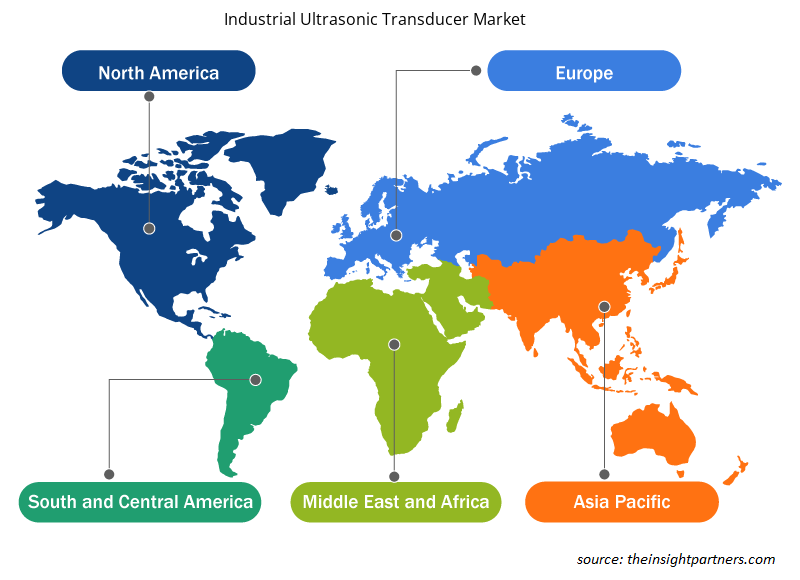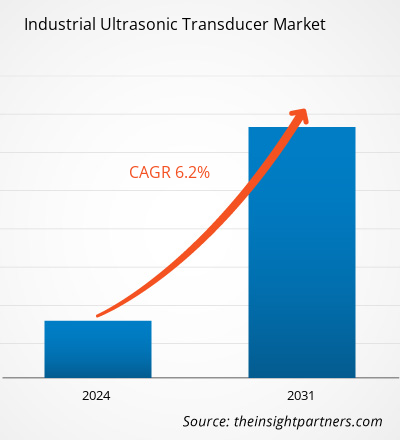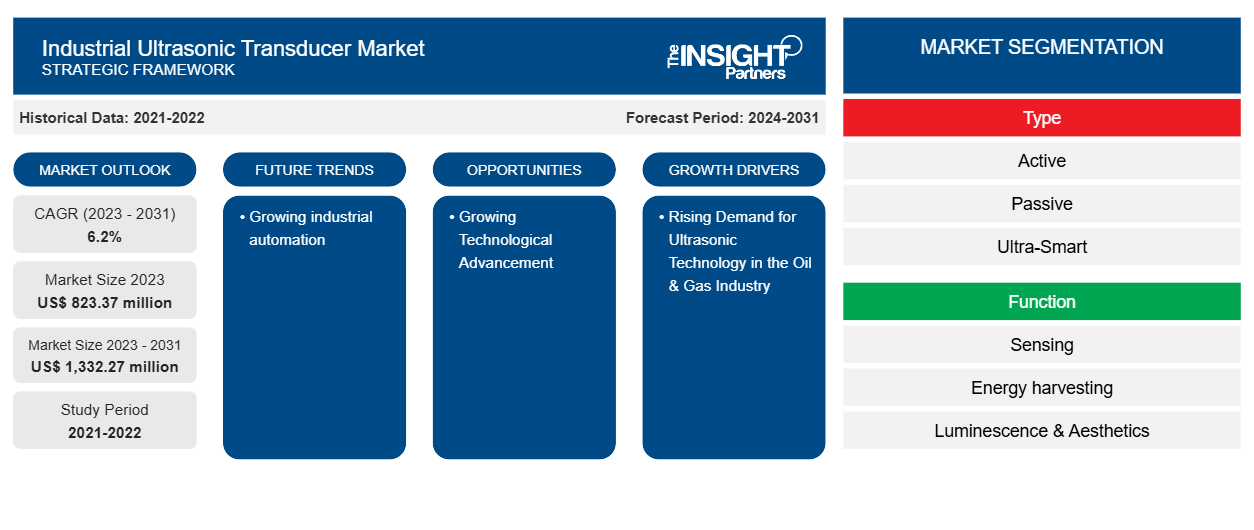Si prevede che la dimensione del mercato dei trasduttori ultrasonici industriali raggiungerà 1.332,27 milioni di dollari entro il 2031, rispetto agli 823,37 milioni di dollari del 2023. Si prevede che il mercato registrerà un CAGR del 6,2% nel 2023-2031. È probabile che la crescente automazione industriale rimanga una tendenza chiave del mercato dei trasduttori ultrasonici industriali.
Analisi del mercato dei trasduttori ultrasonici industriali
Il mercato globale dei trasduttori ultrasonici industriali si sta espandendo rapidamente grazie ai progressi tecnologici e alla domanda crescente in settori quali petrolio e gas, energia ed energia elettrica e altri. La necessità di una lavorazione precisa dei materiali, una pulizia efficace e una misurazione accurata e affidabile sono alcuni degli elementi principali che ne stanno stimolando l'ascesa. Inoltre, si prevede che la crescente adozione di tecnologie IoT e di automazione alimenterà la crescita del mercato nel periodo previsto. Inoltre, si prevede che lo sviluppo di trasduttori ultrasonici più piccoli e altamente efficienti guiderà l'espansione del mercato.
Panoramica del mercato dei trasduttori ultrasonici industriali
I trasduttori a ultrasuoni sono essenziali nei test non distruttivi perché utilizzano onde sonore ad alta frequenza per analizzare parametri importanti. Questi strumenti inestimabili sono utilizzati in molti settori diversi per attività tra cui l'ispezione delle saldature, la misurazione dello spessore e il rilevamento dei guasti. Questi trasduttori forniscono un controllo di processo accurato in contesti industriali, il che aumenta la produzione e garantisce la qualità. Pertanto, la necessità di un controllo di qualità in più settori sta determinando la necessità di trasduttori a ultrasuoni industriali. Inoltre, questi strumenti sono utilizzati nei processi di test non distruttivi (NDT) per identificare vari tipi di difetti dei materiali.
Personalizza questo report in base alle tue esigenze
Riceverai la personalizzazione gratuita di qualsiasi report, comprese parti di questo report, o analisi a livello nazionale, pacchetto dati Excel, oltre a usufruire di grandi offerte e sconti per start-up e università
-
Scopri le principali tendenze di mercato in questo rapporto.Questo campione GRATUITO includerà analisi di dati che spaziano dalle tendenze di mercato alle stime e alle previsioni.
Driver e opportunità del mercato dei trasduttori ultrasonici industriali
Crescente domanda di tecnologia ad ultrasuoni nel settore petrolifero e del gas
I test ultrasonici non distruttivi hanno un impatto significativo sulla sicurezza e sulla produzione di petrolio e gas a monte, a medio e a valle. I test ultrasonici migliorano i tempi di attività delle risorse e riducono il rischio di guasti minori o gravi nei sistemi cruciali di estrazione, raffinazione, stoccaggio e distribuzione del petrolio consentendo ispezioni efficaci di saldature, tubi, rivestimenti e riser per crepe, corrosione o difetti. Riducendo il rischio di responsabilità e perdite di fatturato e aumentando i tempi di attività delle risorse, le apparecchiature di test ultrasonici producono un ritorno sull'investimento, alimentando così la crescita del mercato a livello globale.uptime and lowers the risk of minor or severe failures in crucial oil extraction, refinery, storage, and distribution systems by enabling effective inspections of welds, pipes, uptime, ultrasonic testing equipment yields a return on investment, thus fueling the market growth globally.
Progresso tecnologico in crescita
Si prevede che i progressi della tecnologia dei sensori e l'aumento degli investimenti in R&S alimenteranno l'innovazione nel mercato dei trasduttori ultrasonici industriali. Per soddisfare una varietà di esigenze industriali, i produttori si stanno concentrando sulla creazione di trasduttori sofisticati con prestazioni, robustezza e affidabilità migliorate. Pertanto, si prevede che gli sforzi continui dei produttori per lo sviluppo di trasduttori ultrasonici tecnologicamente avanzati creeranno un'opportunità per la crescita del mercato dei trasduttori ultrasonici industriali nel periodo previsto.forecasted period.
Analisi della segmentazione del rapporto di mercato dei trasduttori ultrasonici industriali
I segmenti chiave che hanno contribuito alla derivazione dell'analisi di mercato dei trasduttori industriali a ultrasuoni sono tipologia, applicazione e settore verticale.
- In base al tipo, il mercato dei trasduttori industriali a ultrasuoni è segmentato in trasduttori a contatto, trasduttori a doppio elemento, trasduttori a immersione, trasduttori a onde di taglio, trasduttori a linea di ritardo e altri. Il segmento dei trasduttori a contatto ha detenuto una quota di mercato maggiore nel 2023.
- Per applicazione, il mercato è segmentato in livello e misurazione, test non distruttivi, controllo di processo e altri. Il segmento dei test non distruttivi ha detenuto una quota di mercato maggiore nel 2023.
- Per settore verticale, il mercato è segmentato in petrolio e gas, energia ed energia elettrica, farmaceutica, cellulosa e carta, metallurgia e ingegneria e altri. Il segmento petrolio e gas ha detenuto una quota di mercato maggiore nel 2023.
Analisi della quota di mercato dei trasduttori ultrasonici industriali per area geografica
L'ambito geografico del rapporto sul mercato dei trasduttori industriali a ultrasuoni è suddiviso principalmente in cinque regioni: Nord America, Asia Pacifico, Europa, Medio Oriente e Africa e Sud America/Sud e Centro America.
In termini di fatturato, l'Asia Pacifica ha rappresentato la quota di mercato più grande per i trasduttori a ultrasuoni industriali. Il mercato in questa regione è segmentato in Australia, Cina, India, Giappone, Corea del Sud e il resto dell'APAC. La crescente necessità di soluzioni di test non distruttivi e la crescente automazione industriale guidano l'espansione del mercato regionale. Inoltre, gli operatori di mercato presenti nella regione lavorano costantemente sugli sviluppi tecnologici nella tecnologia a ultrasuoni, che dovrebbero ulteriormente aumentare la crescita del mercato nel periodo previsto.
Approfondimenti regionali sul mercato dei trasduttori ultrasonici industriali
Le tendenze e i fattori regionali che influenzano il mercato dei trasduttori a ultrasuoni industriali durante il periodo di previsione sono stati ampiamente spiegati dagli analisti di Insight Partners. Questa sezione discute anche i segmenti e la geografia del mercato dei trasduttori a ultrasuoni industriali in Nord America, Europa, Asia Pacifico, Medio Oriente e Africa e America meridionale e centrale.

- Ottieni i dati specifici regionali per il mercato dei trasduttori ultrasonici industriali
Ambito del rapporto di mercato sui trasduttori ultrasonici industriali
| Attributo del report | Dettagli |
|---|---|
| Dimensioni del mercato nel 2023 | 823,37 milioni di dollari USA |
| Dimensioni del mercato entro il 2031 | 1.332,27 milioni di dollari USA |
| CAGR globale (2023-2031) | 6,2% |
| Dati storici | 2021-2022 |
| Periodo di previsione | 2024-2031 |
| Segmenti coperti |
Per tipo
|
| Regioni e Paesi coperti |
America del Nord
|
| Leader di mercato e profili aziendali chiave |
|
Densità degli attori del mercato: comprendere il suo impatto sulle dinamiche aziendali
Il mercato dei trasduttori industriali a ultrasuoni sta crescendo rapidamente, spinto dalla crescente domanda degli utenti finali dovuta a fattori quali l'evoluzione delle preferenze dei consumatori, i progressi tecnologici e una maggiore consapevolezza dei vantaggi del prodotto. Con l'aumento della domanda, le aziende stanno ampliando le loro offerte, innovando per soddisfare le esigenze dei consumatori e capitalizzando sulle tendenze emergenti, il che alimenta ulteriormente la crescita del mercato.
La densità degli operatori di mercato si riferisce alla distribuzione di aziende o società che operano in un particolare mercato o settore. Indica quanti concorrenti (operatori di mercato) sono presenti in un dato spazio di mercato in relazione alle sue dimensioni o al valore di mercato totale.
Le principali aziende che operano nel mercato dei trasduttori industriali a ultrasuoni sono:
- Audiowell Electronics (Guangdong) Co., Ltd.
- APC Internazionale, Ltd.
- Crest Ultrasuoni Corporation
- CORPORAZIONE OLYMPUS
- Optel
- Tecnologie piezoelettriche
Disclaimer : le aziende elencate sopra non sono classificate secondo un ordine particolare.

- Ottieni una panoramica dei principali attori del mercato dei trasduttori ultrasonici industriali
Notizie e sviluppi recenti sul mercato dei trasduttori ultrasonici industriali
Il mercato dei trasduttori industriali a ultrasuoni viene valutato raccogliendo dati qualitativi e quantitativi dopo la ricerca primaria e secondaria, che include importanti pubblicazioni aziendali, dati associativi e database. Di seguito è riportato un elenco degli sviluppi nel mercato:
- PI Ceramic ha annunciato che, per la prima volta, ha presentato la sua nuova classe di trasduttori ultrasonici di potenza al COMPAMED 2023. Questi trasduttori Langevin sono utilizzati nella preparazione di campioni microfluidici. In questi trasduttori, gli anelli piezoelettrici creano onde ultrasoniche, che vengono poi amplificate fino alla punta del dispositivo per avviare vibrazioni nel mezzo target. Oltre che nella microfluidica, questo principio può essere utilizzato anche in molte altre applicazioni nella tecnologia medica, ad esempio, l'aspirazione di tessuti, la facoemulsificazione o i bisturi ultrasonici. (Fonte: PI Ceramic, Comunicato stampa, 2023)
- La startup high-tech di Monaco di Baviera Toposens ha annunciato il lancio del suo sensore di ecolocalizzazione ultrasonica 3D ECHO ONE. Basato sul principio di ecolocalizzazione osservato nei pipistrelli, Toposens ECHO ONE compensa gli svantaggi dei sensori ottici tramite triangolazione basata sul suono in combinazione con un sofisticato software di filtraggio del rumore. Questo, a sua volta, fornisce un output di dati 3D robusto in tempo reale per ogni ostacolo rilevato all'interno delle zone di avviso e arresto completamente regolabili. (Fonte: Toposens, comunicato stampa, 2022)
Copertura e risultati del rapporto sul mercato dei trasduttori ultrasonici industriali
Il rapporto "Dimensioni e previsioni del mercato dei trasduttori ultrasonici industriali (2021-2031)" fornisce un'analisi dettagliata del mercato che copre le seguenti aree:
- Dimensioni e previsioni del mercato a livello globale, regionale e nazionale per tutti i segmenti di mercato chiave coperti dall'ambito
- Dinamiche di mercato come fattori trainanti, vincoli e opportunità chiave
- Principali tendenze future
- Analisi dettagliata delle cinque forze PEST/Porter e SWOT
- Analisi di mercato globale e regionale che copre le principali tendenze di mercato, i principali attori, le normative e gli sviluppi recenti del mercato
- Analisi del panorama industriale e della concorrenza che copre la concentrazione del mercato, l'analisi della mappa di calore, i principali attori e gli sviluppi recenti
- Profili aziendali dettagliati
- Analisi storica (2 anni), anno base, previsione (7 anni) con CAGR
- Analisi PEST e SWOT
- Valore/volume delle dimensioni del mercato - Globale, Regionale, Nazionale
- Industria e panorama competitivo
- Set di dati Excel
Report recenti
Testimonianze
Motivo dell'acquisto
- Processo decisionale informato
- Comprensione delle dinamiche di mercato
- Analisi competitiva
- Analisi dei clienti
- Previsioni di mercato
- Mitigazione del rischio
- Pianificazione strategica
- Giustificazione degli investimenti
- Identificazione dei mercati emergenti
- Miglioramento delle strategie di marketing
- Aumento dell'efficienza operativa
- Allineamento alle tendenze normative























 Ottieni un campione gratuito per - Mercato dei trasduttori ultrasonici industriali
Ottieni un campione gratuito per - Mercato dei trasduttori ultrasonici industriali